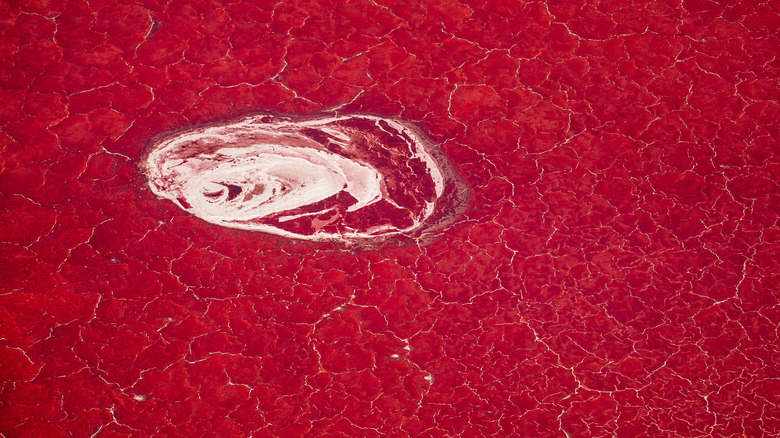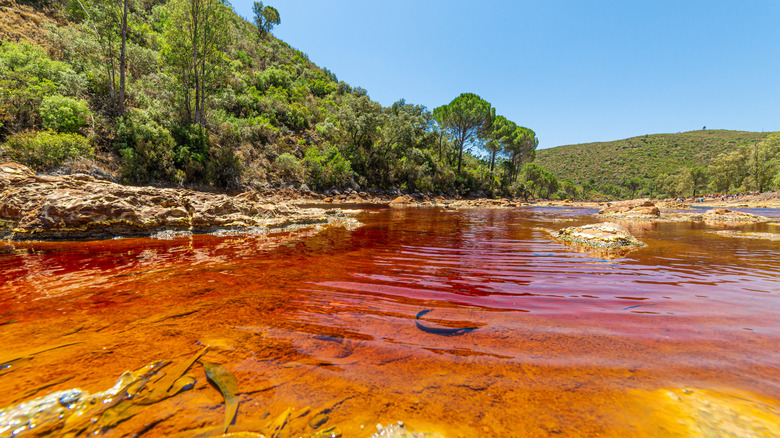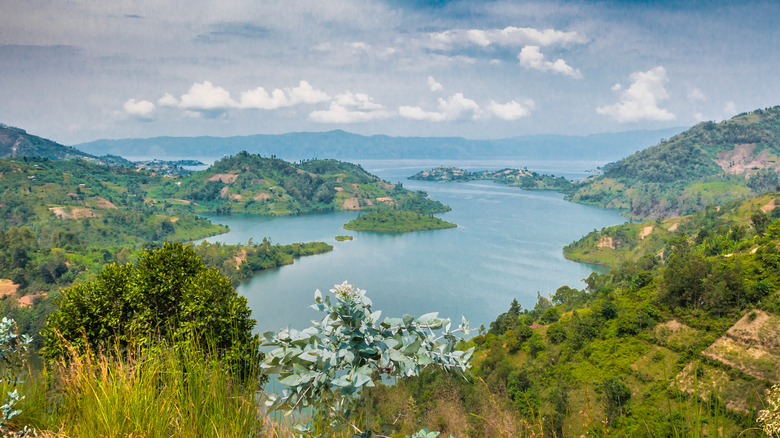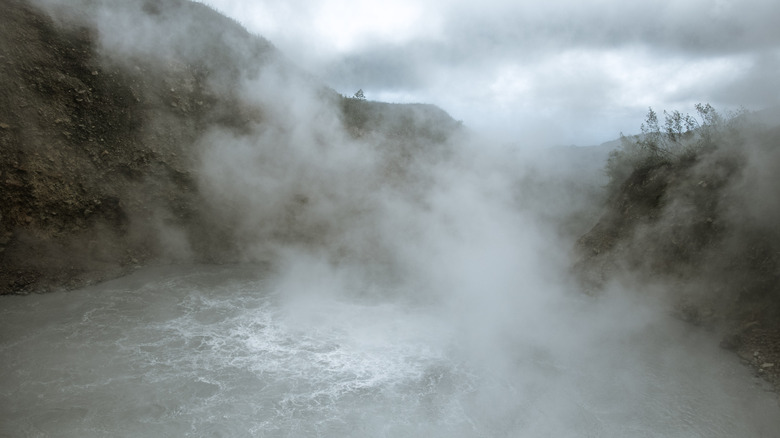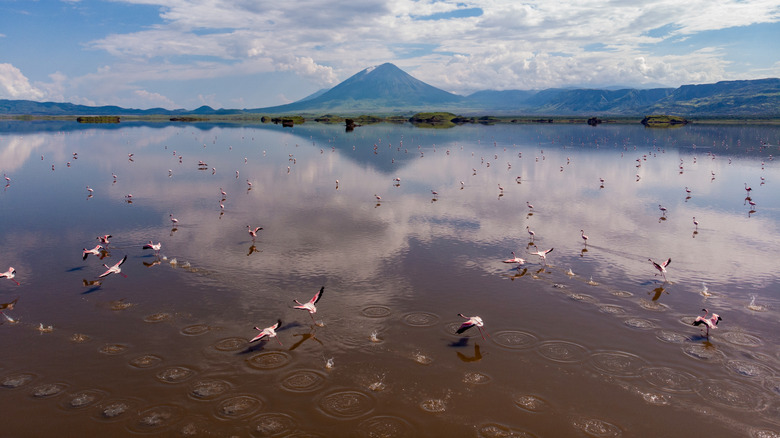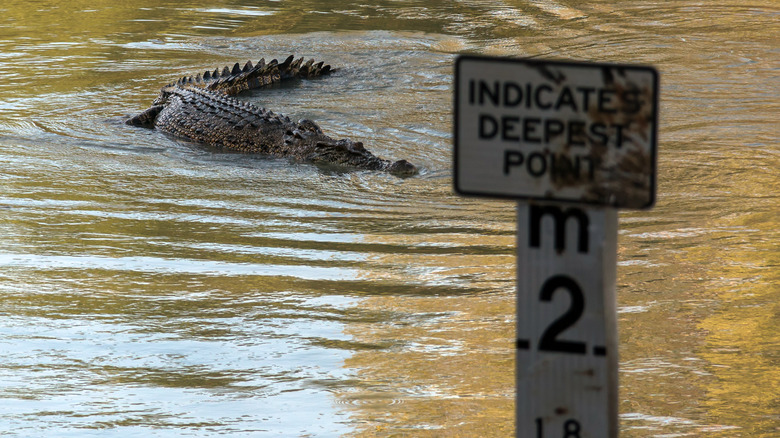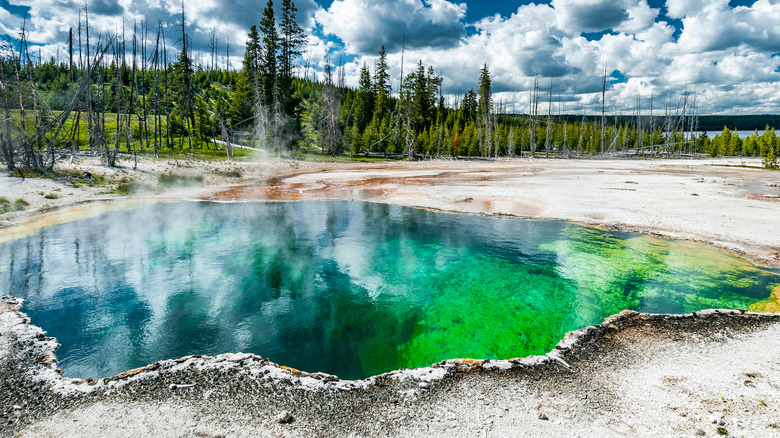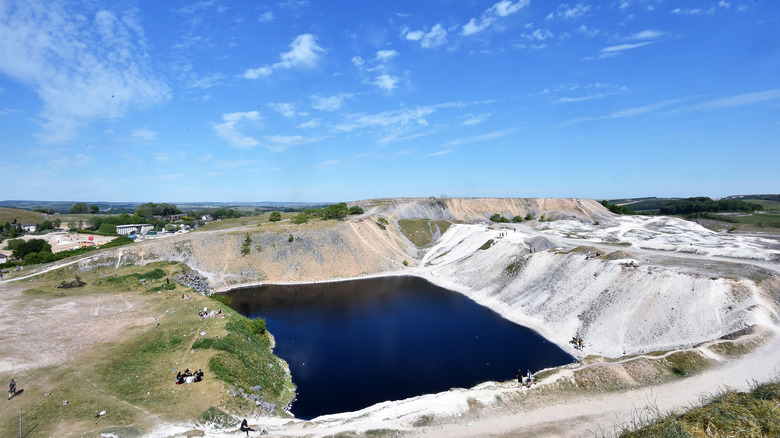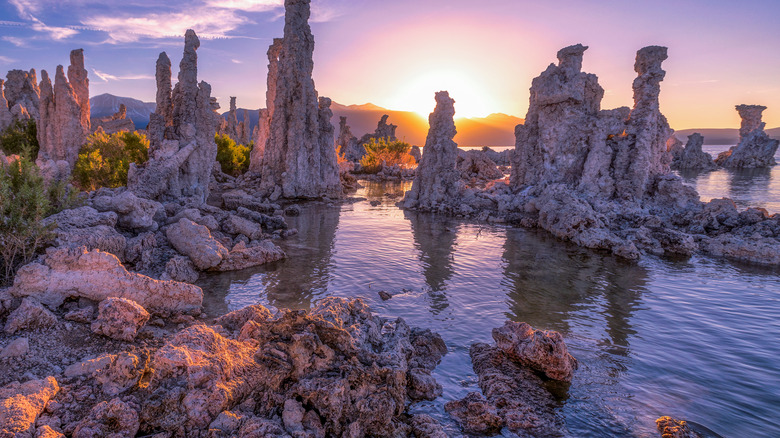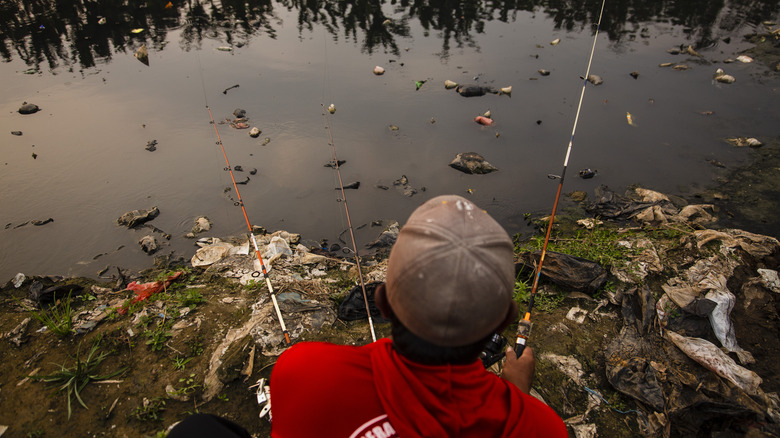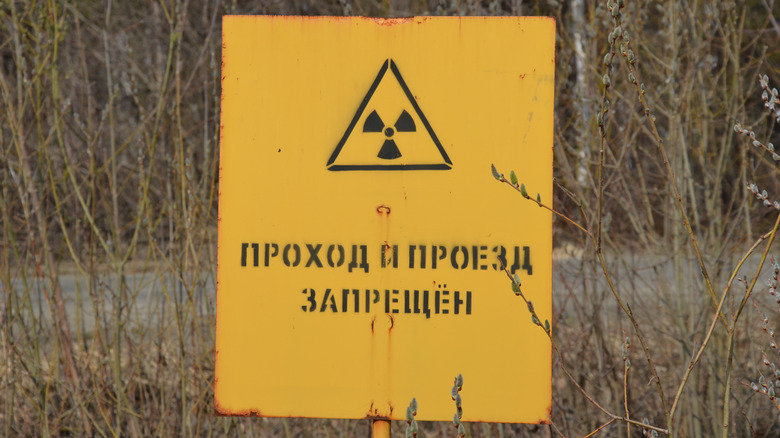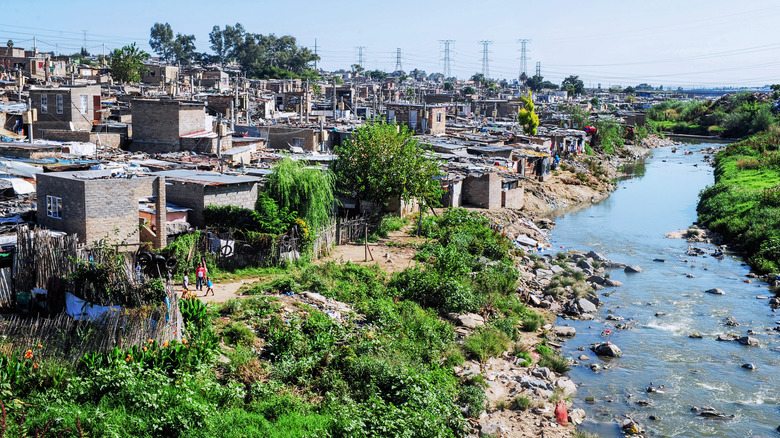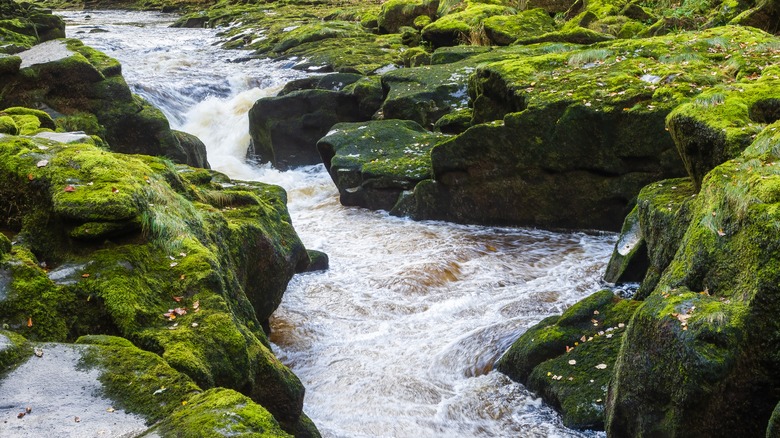Bodies Of Water Too Dangerous For Anybody To Touch
It's easy to take water for granted. Drinking water aside, there's the vast oceans and seas we're fortunate enough to be able to enjoy, the rains, the trickling streams, the rivers ... but here's the thing: Not all bodies of water are created equal, and some? Some aren't exactly life-giving or sustaining.
The question of where Earth's abundance of water came from is a tricky one. According to the BBC, there's water sprinkled across the solar system, and it's believed Earth's water came from the ice-covered dust that started coalescing into the planets about 4.6 billion years ago. The running theory is that water was deposited on Earth by astronomical bodies — such as asteroids — that struck the surface of the young planet, so that's lucky.
Over millions of years, the forces of water have shaped the planet into what it is today. Along the way, some bodies have turned downright deadly. For some, it was the perfect storm of natural forces. In other cases, humans have ruined things. Let's look at some bodies of water that have always been dangerous, and some that we made that way.
Rio Tinto, Spain
The Rio Tinto river system is located in the southwest corner of Spain, not far from the nation's border with Portugal. It's an undeniably gorgeous area with a rich history, but unfortunately, the fact that the area is rich in something else — minerals — has done catastrophic damage to the waters there.
According to research done by the University of South Florida, mining activities in the Rio Tinto area started a whopping 5,000 years ago — and yes, that's about 3,000 B.C. Rich in everything from sulfide to iron, copper, silver, and gold, the area is thought to be the location of the genesis of both the Bronze and Copper Ages. Mining operations have been run by everyone from the Romans to the Visigoths, all the way through history up to silver and gold mining that only ended in 1996.
Unfortunately, that's polluted the river to a shocking extent. According to the Andalusia Tourist Community, anyone in the vicinity of the river is advised not to touch it — and if they do, they should definitely not touch their face before using a cleaning solution designed to handle the pollutants. Anything metal dropped into the river will be irreparably damaged, and the only life supported is bacteria. In fact, the site has often been studied by NASA because of the similarity it bears to the inhospitable environment on Mars.
Lake Kivu, Rwanda and the Democratic Republic of Congo
Here's the thing about Lake Kivu: Most of the time, it's a perfectly pleasant lake, sitting on the border between Rwanda and the Democratic Republic of Congo. But it's also a terrifying, ticking time bomb that could — at almost any moment — kill the millions of people living nearby.
How? It's complicated, but basically, the BBC says that unlike most lakes that are warm on the surface and cooler below, Lake Kivu's deep waters are warmed by nearby volcanic activity. That means the depths of the lake are so warm that organic processes that are usually dormant in colder lakes can happen, and that includes the breaking down of plant and animal matter and the production of methane. The methane is formed, but it doesn't rise — instead, it's building up in the 1,500-foot-deep lake. The result is that the lake has several distinct layers, with the bottom layers filled with gases including methane and carbon dioxide.
In some projected scenarios, the gas just builds up to a point where it essentially explodes and instantly suffocates everything nearby under a blanket of unbreathable gas. Tectonic activity, landslides, or volcanic tremors could also release the gas, and it's happened elsewhere on a smaller scale. In 1986, Lake Nyos in Cameroon experienced this explosion of gas, which killed around 1,800 people who were living nearby. Should the same thing happen to Kivu — which is twice as deep and about 55 times as long as Nyos — the death toll could be in the millions.
Boiling Lake, Dominica
While there's nothing quite as relaxing as a long soak in a hot tub, Dominica's Boiling Lake is something else entirely. For some context, it's located near the Valley of Desolation ... so there's the first hint at just how bizarre this place is.
Boiling Lake is one feature of a landscape shaped by around 200 millions years of volcanic activity, and it's essentially a body of water that's been super-heated by all that magma that's still bubbling away just beneath the surface... relatively speaking. The University of the West Indies Seismic Research Centre advises visitors to definitely not go near the water, and in fact, says that it's only safe to view the lake from a nearby crater rim... and then, only for a very short time.
So, how hot are we talking here? According to A Virtual Dominica, records of a scientific study of the lake go back to English explorers sent to document it back in the early 1870s. While they were unable to reach the center of the lake — which was actually boiling — they did document areas closer to the shore as ranging from between 180 to 197 degrees Fahrenheit. For a comparison, Jacuzzi says hot tub temperatures are most comfortable when they're between 100 and 102 degrees Fahrenheit... and they add that it shouldn't be above 104. According to the U.S. Consumer Product Safety Commission, touching 150-degree water for just two seconds will result in third-degree burns.
Lake Natron, North Tanzania
Flamingos are weird, and anyone who thinks otherwise hasn't taken a good, long look at these massive pink birds... and their strange, soulless eyes. Proof? According to Smithsonian Magazine, about 75% of lesser flamingos are born around a lake that's toxic to just about everything else. Those unnervingly long flamingo legs are part of what makes this a paradise for them: The leathery skin protects them from the caustic waters, and when they nest on the islands of crystalized salt that develop, they're kept well out of the reach of predators.
What makes the lake so dangerous is just as weird. According to IFLScience, the lake sits in the blast radius of a volcano. It's not just any volcano, though; it's the only one in the world to spit out something called natrocarbonatite. The minerals in the volcanic material have, over time, turned the lake into something otherworldly. In addition to the extreme alkalinity, the lake is also extremely hot — reaching temperatures up to 140 degrees Fahrenheit — and salt deposits have formed craggy outcroppings and islands sharp enough to shred boats.
Made famous by photographer Nick Brandt's series of the calcified animals that died there, the lake isn't a place to explore carelessly. The water is capable of leaving corrosive burns on the skin of anyone foolish enough to try to touch it, dehydration can set in at around the half-hour mark, and after death? Decomposition stops, and bodies are essentially pickled.
Cahills Crossing, Australia
According to ABC News, Cahills Crossing isn't home to just a handful of saltwater crocodiles; it's "infested" with them. The entire area is covered with signs warning people to stay a good distance away from the water, don't approach the shore, don't try to walk through the water, and actually? Don't even try to cross it unless you have the right kind of vehicle. Even then, the strong current has been known to flip vehicles into the — let's say it again — "crocodile-infested river." That's no exaggeration: As many as 40 crocs — which reach lengths of around 13 feet — have been seen in the area at one time.
Do people listen to the warning? Of course not! Have they died there? Of course they have.
One man decided to go fishing at the crossing in 1987, only to be decapitated by a crocodile (via News.com.au). When three people walked across in 2017, two got to the other side to find their companion was simply gone. (His remains were recovered several miles downstream.) ABC radio presenter Leon Compton was there in the summer of 2022 and recorded scores of tourists on the edge of the water — feet away from crocs. He predicted: "Someone is going to die. ... it is only a matter of time."
Yellowstone's Hot Springs, USA
In August 2022, the Associated Press reported that park officials at Yellowstone National Park had made a grisly discovery: a shoe, with part of a foot still inside. The remains had been discovered at a hot spring called the Abyss Pool, which reaches temperatures up to 140 degrees Fahrenheit. WAFB News reported that it wasn't the first death that had happened at the scalding hot, highly acidic waters, and that acidic part? That's particularly terrifying.
In 2016, Colin Scott and his sister were looking for a place to — illegally — swim in the hot springs. According to The Guardian, Scott slipped and fell in an off-limits section of the park. When authorities arrived to initiate a rescue, they could see him — but, he was already very obviously dead. An approaching lightning storm put the recovery of his body on hold until the following morning, when "the consensus among the rescue/recovery team ... was that the extreme heat of the hot spring, coupled with its acidic nature, dissolved the remains."
Yellowstone stresses that with more than 4 million visitors every year, accidents are rare but they do happen. More than 20 people have been killed in and around Yellowstone's network of geysers, hot springs, and geothermal pools, some of which can reach temperatures of up to 250 degrees Fahrenheit.
The Blue Lagoon, England
In 2012, the BBC reported that the residents of Harpur Hill and Buxton were having a massive problem: People were coming from all across the country — and even internationally — to swim at their undeniably picturesque lagoon. The water was so blue that it looked both inviting and unnatural — the former, it shouldn't have been, and the latter? Well, it was unnatural.
Derbyshire Live reports that the vibrant blue is actually a side effect of cold rains mixing with the scores of chemicals still on the site from years of industrial use. From as far back as the 1600s, the site was used to produce quicklime — and it was used for that purpose for around 300 years. During World War II, the RAF used the site for storing chemical weapons, and then for disposing of chemical weapons seized from Germany. The disposal part essentially meant burning off things like mustard gas. Since then, the whole site has turned from a chemical soup to a chemical stew — complete with, as the signs warn, dead animals and wrecked cars.
When studies found that the lagoon was too toxic to drain (for fear of contaminating the area's drinking water), it was decided to dye the pool black. That proved more effective at deterring swimmers, and worked better than posted warnings that the water could cause skin and eye irritation and gastrointestinal damage, and was as caustic as bleach.
Mono Lake, USA
California's Mono Lake has a number of things going on, starting with the fact that it contains levels of arsenic about six times higher than what's considered safe for drinking (via Atlas Obscura). It's also home to a newly discovered species of roundworms that actually thrive on arsenic.
But we're talking about lakes that aren't safe to touch, not lakes that aren't safe to lick. According to the Los Angeles Times, the real danger in Mono Lake isn't from the water at all, but from the lake bed. In the autumn months, the waters of the lake recede and reveal the lake bed, which then kicks up scores of fine dust particles called PM10 particulate. Anyone who's close enough to touch the water is breathing in the dust, and that's a huge problem — it's so fine it can become lodged in a person's respiratory system and even end up polluting the bloodstream.
The U.S. Environmental Protection Agency lists scores of other health issues linked with this particulate, including the likelihood it'll worsen existing conditions such as asthma, but it's also connected to decreased lung function, difficulty breathing, and instances of heart attacks. Mono Lake is such a major source of the particulate that it impacts not just those at the water's edge, but the communities around the lake, too, causing what is described as a public health crisis.
Citarum River, Indonesia
The world is about as far from perfect as it can get, and just because a waterway might be too dangerous to touch, that doesn't mean that people always have a choice in the matter. Take Indonesia's Citarum River. It's called the dirtiest in the world, but around 9 million people live in close contact with it (via The Guardian), and about 30 million rely on the highly polluted waters to irrigate the crops that feed their families (via DW).
When it comes to talking about what's in the river, it's almost easier to talk about what isn't in it. The Citarum is polluted with everything from household waste and sewage to heavy metals from large-scale industry, particularly the textile factories that sit along the shores and pump their waste into the water. There are somewhere around 2,000 factories that use the river as a dumping ground, and here's an incredibly disturbing tidbit: The levels of fecal bacteria in the water are about 5,000 times higher than what's deemed safe to be near.
Countless people have no choice but to cook with and drink water right from the river, and predictably, that's caused more health problems than it's possible to list. Among them? High instances of tumors, renal failure, chronic bronchitis, dermatitis, contact rashes, and delayed development in children. Large-scale clean-up efforts have been started, but it's a very slow process.
Lake Karachay, Russia
The waters of Russia's Lake Karachay aren't just dangerous, they're deadly — and according to Russia Beyond, the lake is one of the most polluted places in the world. This is no ordinary pollution, either. The lake sits near the once top-secret Mayak Production Association, and according to Grist, it wasn't until the 1990s that the existence of the facility was even acknowledged. For somewhere around 40 years, the lake was the dumping grounds for all the radioactive waste generated by the plant — and by the time it all went public, the entire area contained so much radioactivity that standing along the shores of the lake for about an hour would mean a gruesome death from exposure to radiation. To put things in perspective, levels of radioactivity were more than twice what Chernobyl saw immediately after the 1986 meltdown.
Over the years, there have been incidents that have made the entire mess even worse. In the 1960s, water levels dropped during a drought, exposing more toxic chemicals than usual, and winds later spread the waste over a massive swath of land. Since the facility was secret at the time, locals who died from radiation sickness were said to have succumbed to the "special disease."
Although the lake has been filled in with concrete in order to try to make it at least a little safer, how effective that's been is up for debate. The river upstream of the lake is still highly radioactive, and will be for centuries.
Jukskei River, South Africa
In 2022, the BBC reported on a heartbreaking tragedy: 14 people were killed while taking part in a church service on South Africa's Jukskei River. The river, said City of Johannesburg Emergency Management Services spokesman Robert Mulaudzi, was prone to flash flooding, particularly during the rainy season.
That's not the only thing that makes the river dangerous, though. According to a report from Ecologist, the Jukskei — which runs right through the heart of Johannesburg — is teeming with E. coli. The source is the raw sewage that gets dumped into the river as it passes through the city, particularly through crowded areas like the Alexandra Township. Many toilet facilities discharge directly into the river and many more people — who live without adequate sanitation — dump buckets into the flowing waters. The result is a river with a concentration of E. coli bacteria that's much, much higher than the acceptable 500 parts per 100 ml. In 2016, testing revealed the Jukskei River contained a shocking 1.5 million parts per that same 100 ml.
Cleanup plans were being developed, but testing done by the University of Johannesburg in 2021 revealed that little had improved: The waters were still filled with raw sewage containing all the expected bacteria, along with substances such as lead, nickel, and lithium — all of which were connected with higher rates of cancer, cell damage, and chronic conditions including pneumonia, infections, and a slew of diseases.
The Bolton Strid, England
At a glance, it looks like something that was plucked right out of Arthurian legend. The Bolton Strid is a strangely narrow creek that's a seemingly idyllic stretch of Yorkshire waterway. It's part of the much wider River Wharfe — and that's precisely the problem.
According to The New York Times, locals warn that the river has claimed 100% of the people who are unfortunate enough to fall in — and given that it seems narrow enough to jump but is flanked by very, very slippery rocks, there are signs warning visitors that they need to stay well back from the edge. What, precisely, is the problem?
As the River Wharfe runs past an old monastery, it's shallow and slow enough to wade across. It's about 30 feet wide... until it's not. That's where the Strid starts, at a place where the rocks narrow the river and instead of being wide, it's deep. Underwater caverns and crevices create deadly currents that smash unfortunate trespassers against the rocks or trap them underwater. It's so notorious that its dangers are even referenced in 19th century literature. Attempts at measuring the depth of the river have constantly been thwarted until — perhaps — 2021. That's when a Lake District YouTuber used sonar to try to determine the depth, and reportedly measured it at a shocking 213 feet (via the Telegraph & Argus).
